How trace mineral capacity influences nutrient stability
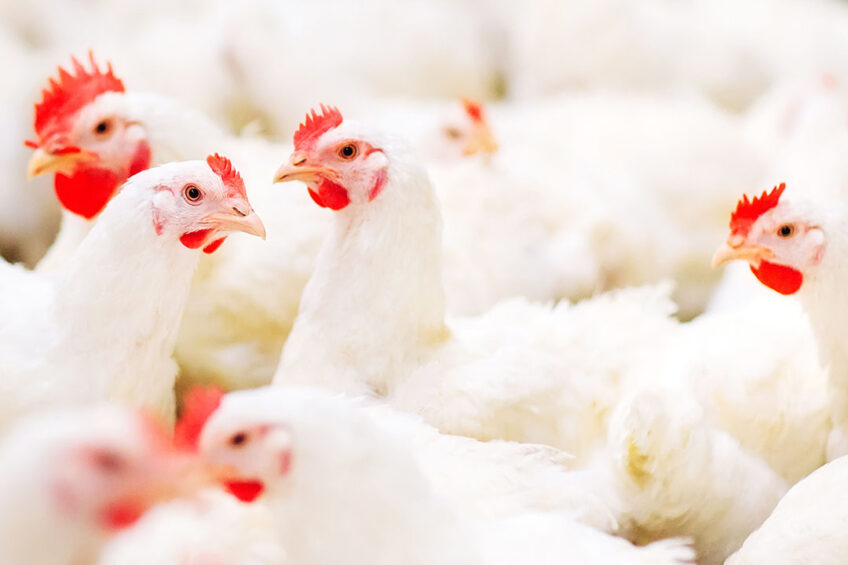
As the impacts of climate change become more evident, extreme weather events like El Niño are affecting various aspects of agriculture, including the stability of feed premixes and the nutrient value of poultry diets.
The interaction between atmospheric conditions and the efficacy of feed ingredients, particularly trace minerals, in hot and humid environments is a critical consideration. This article explores the importance of selecting a trace mineral with the capacity to maintain nutrient stability and improve poultry performance during challenging weather conditions.
Trace minerals and nutrient stability
Several factors must be considered when developing a poultry diet, including the nutritional components required, the cost and availability of ingredients, as well as the quality and handling of the ingredients. However, less thought is given to how ingredients interact with other components of the diet and moisture in the environment.
Some ingredients, including poor-quality trace minerals, can react with these other components in the diet. This reactivity can lead to undesirable interactions with environmental conditions, particularly moisture. Some trace minerals, such as sulphate trace minerals with an ionic bond structure, are more reactive to environmental conditions than others. When moisture is present, sulphate trace minerals can dissolve and dissociate making them reactive to other ingredients in the diet. Expensive components such as vitamins, enzymes and fats can be impaired by this reactivity.
Impact of moisture
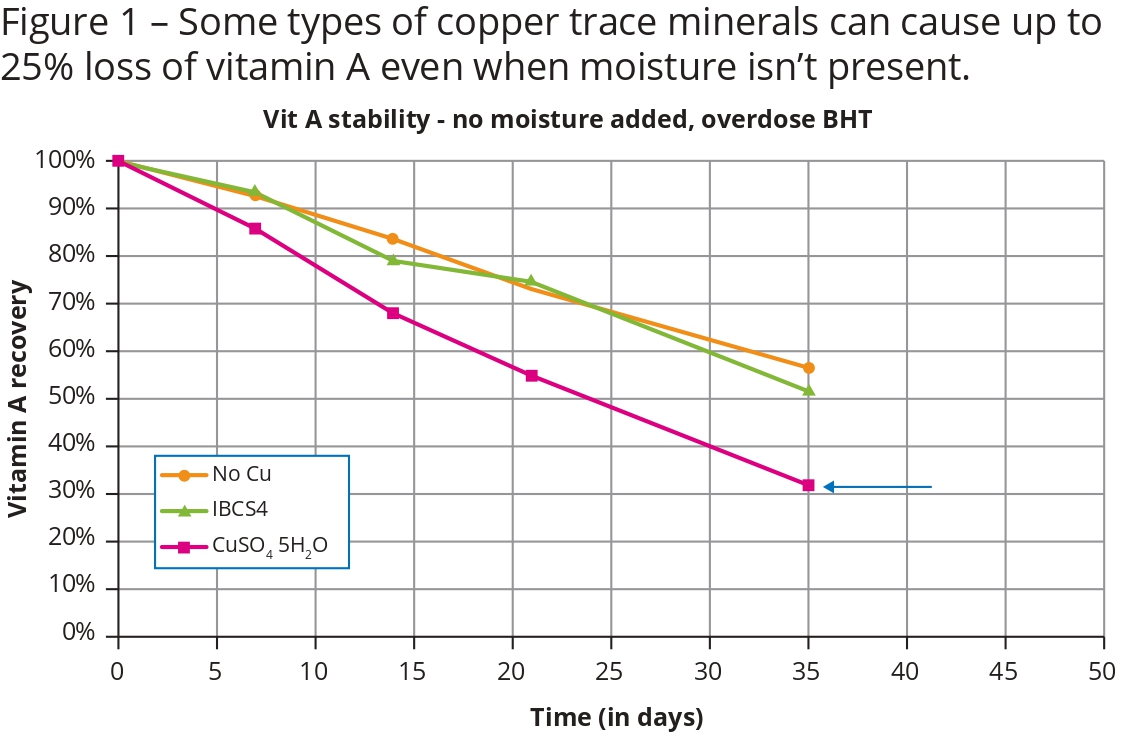 A study was conducted to investigate the interaction between trace minerals and dietary elements, such as vitamins, in the presence or absence of moisture. In this study looking at the interaction between dietary vitamins and trace minerals, several types of copper trace minerals were investigated for use in combination with vitamin A. Realistic amounts of copper sulphate (CuSO4), copper hydroxychloride (IntelliBond Copper) and vitamin A were combined with the antioxidant BHT and tested for a reaction both with and without moisture present. The test looked for evidence of vitamin A degradation in the sample.
A study was conducted to investigate the interaction between trace minerals and dietary elements, such as vitamins, in the presence or absence of moisture. In this study looking at the interaction between dietary vitamins and trace minerals, several types of copper trace minerals were investigated for use in combination with vitamin A. Realistic amounts of copper sulphate (CuSO4), copper hydroxychloride (IntelliBond Copper) and vitamin A were combined with the antioxidant BHT and tested for a reaction both with and without moisture present. The test looked for evidence of vitamin A degradation in the sample.When copper sulphate was mixed with vitamin A, there was a 25% degradation of the vitamin even when no moisture was present to increase reactivity. However, IntelliBond C did not generate a greater reduction in vitamin level. There was some degradation when IntelliBond C was added and moisture was present but there was more dramatic vitamin A loss when copper sulphate was used.
Like vitamins, trace minerals can interact with enzymes added to diets, especially in hot, humid situations when ambient moisture is present. Enzymes, such as phytase, are frequently used in poultry feed to improve precision formulation and reduce nutrient waste. However, if such enzymes react with trace minerals in the diet, their efficacy is reduced. A study comparing copper sulphate to IntelliBond C found a 17% increase in phytase activity or phosphorus retention when copper hydroxychloride was used instead of copper sulphate.
Particle size matters
Research has shown that the particle size of trace minerals can play a crucial role in maintaining nutrient stability. Smaller particles of copper sulphate tend to lead to faster nutrient degradation, while larger particles exhibit better stability. In contrast, IntelliBond C performs better than copper sulphate, ensuring nutrient retention and stability even in the presence of moisture.
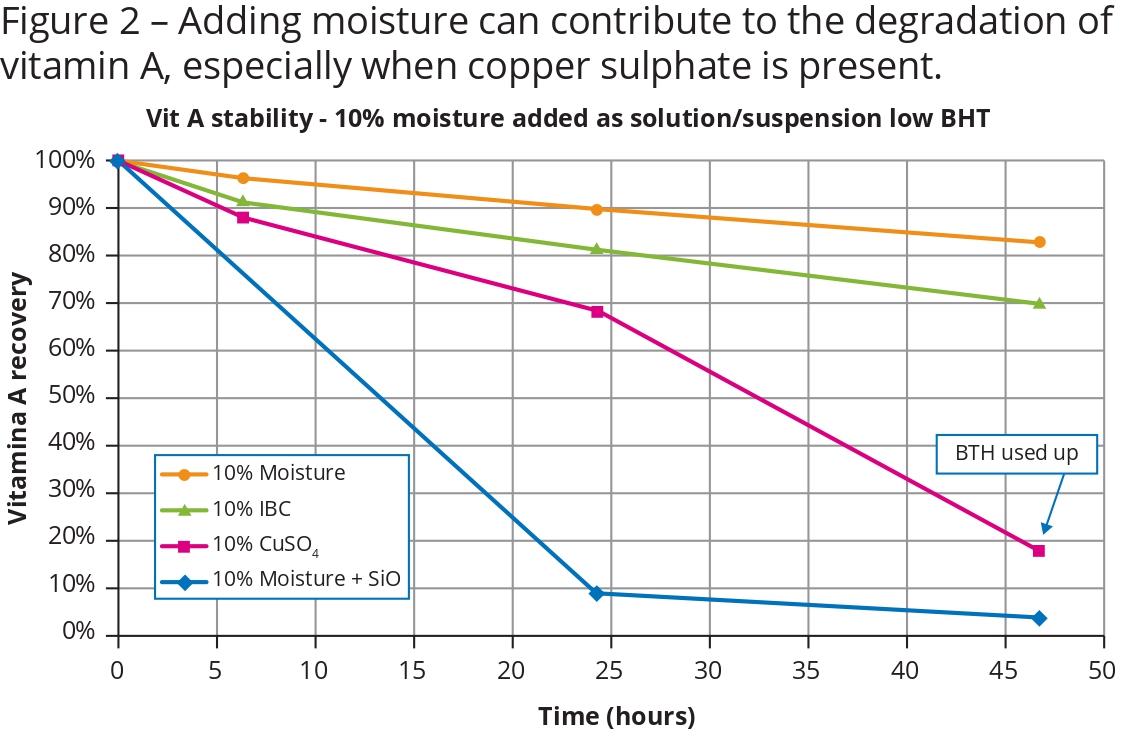 A research trial examined how quickly vitamin A degraded when moisture was present, and when moisture was present and different types of copper trace minerals were used. When no copper was present, the stability of the vitamin A declined slowly – on the final day of the trial (day 14) about 40% of the vitamin still remained. Adding copper sulphate to the mix saw a dramatic response based on particle size, with larger particles being more stable. Adding copper sulphate with particles of less than 75 um – the smallest particle size used – vitamin A stability dropped to almost 0% by day 12 of the trial.
A research trial examined how quickly vitamin A degraded when moisture was present, and when moisture was present and different types of copper trace minerals were used. When no copper was present, the stability of the vitamin A declined slowly – on the final day of the trial (day 14) about 40% of the vitamin still remained. Adding copper sulphate to the mix saw a dramatic response based on particle size, with larger particles being more stable. Adding copper sulphate with particles of less than 75 um – the smallest particle size used – vitamin A stability dropped to almost 0% by day 12 of the trial.
When copper hydroxychloride was added to the mix, degradation increased slightly with about 38% remaining after 14 days. When copper sulphate was added with particles of the same size as the IntelliBond C, vitamin A stability dropped more quickly falling to about 25% by day 11.
Economics of diet formulation
When considering the economics of diet formulation, the cost of ingredients is a crucial factor. Sulphate-based trace minerals have long been favoured for their low cost compared to alternatives like hydroxy and organic trace minerals. However, the potential harm they can cause to other diet components and the hidden costs associated with this damage are often overlooked. Conversely, IntelliBond trace minerals offer a cost-effective and safe alternative that not only ensures better poultry performance but also protects the nutritional integrity of the diet.
Advantages of IntelliBond Stability
IntelliBond minerals offer a range of benefits that make them an attractive option for poultry diets. These advantages include improved nutrient stability, reduced nutrient degradation, better feed conversion rates and enhanced weight gain in birds. Additionally, IntelliBond minerals have the capacity to ensure that the trace minerals do not react adversely with other diet components due to their covalent bonds, thereby making them ideal for use in hot and humid conditions.
As the frequency of extreme weather events rises due to climate change, it is crucial to consider the impact of environmental conditions on poultry diet stability and nutrient retention. By utilising IntelliBond minerals with IntelliBond ability, poultry producers can safeguard their dietary components and optimise feed formulations even with challenging weather patterns. With improved nutrient stability and enhanced poultry performance, the incorporation of IntelliBond minerals becomes a smart investment for the future of poultry farming.
References available on request.
Join 31,000+ subscribers
Subscribe to our newsletter to stay updated about all the need-to-know content in the poultry sector, three times a week. Beheer
Beheer

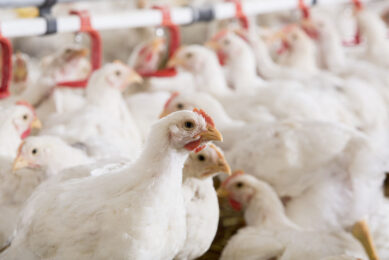

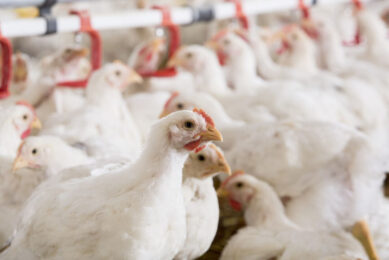
 WP Admin
WP Admin  Bewerk bericht
Bewerk bericht